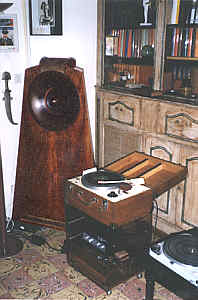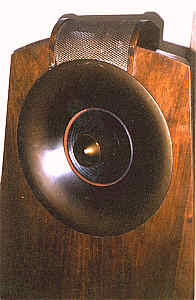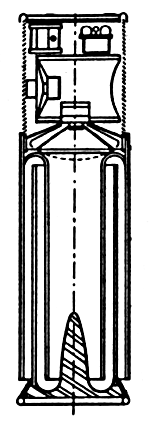|
André Charlin's interest in loudspeakers began early. In 1922 he patented
an electrodynamic loudspeaker, three years before Rice and Kellogg who are
usually attributed as it's inventors (Chester W Rice and Edward W Kellogg
worked on their speaker between 1922 and 1924, it was launched as a
commercial product in 1925). Very early he also started work on electrostatic loudspeakers, receiving a patent for a push-pull electrostat 1926. Electrostatic loudspeakers started appearing all over the world between 1925 and 1927, but were mostly of the single-ended variety. In 1927 different models (for reproduction of the higher frequency spectrum) were suggested by, apart from Charlin, the Englishman C. Kyle, the German Eugène Reitz and the Japanese T. Kageyama. There were also several demonstrations by Slepian, Edelman, Kellogg and Voigt. 1927 the German Hans Vogt presented a working push-pull electrostat at the Berlin Radio Exhibition. We are trying to establish whether Charlin or Vogt was the earliest documented inventor. The Belphégor
The ColonnesThere has been 5 models of Colonne loudspeakers that we know of (the numbers signify model as well as height (in centimetres)); 110 120 122 160 190 The 120 model was replaced by the 122 in 1970. An undated brochure (probably from 1973) state: "The 110 Colonnes are specifically meant to be used as additional speakers in a tetraphonic (4-channel) layout. They have two ESL tweeters and only one electrodynamic driver; their bass range is limited to 40 Hz. The 122 Colonnes reach 32 Hz, the 160 Colonnes go down to 16 Hz and the 190 colonnes reach all the way down to TEN (!) Hz". An interesting question wich we are researching at the moment is how the electrostatic drive was achieved. All the Charlin tube amplifiers we have come across have four output terminals, two for the dynamic drivers and two for the high voltage feed to ESL's (see also the Colonne filter schematic below). In 1970 Revue du Son stated that all Charlin Colonnes could now be driven directly by any tube or transistor amplifier. This is only partially confirmed by the 1973 prospectus, which state that the Colonnes are "adaptable", not specifying whether this requires any adjustment. The 1975 documentation, however, expressly states that "these 8 ohm loudspeakers can be connected without any specific adjustment to any amplifier of good quality". But who better to present his loudspeakers than André Charlin himself, what follows here is a translation of one of his sales brochures: 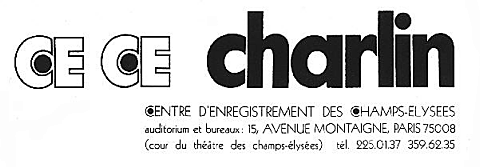
These Colonnes represent the crowning achievement of 50 years of experience, as André Charlin's research began in 1922 with his patents for the electrodynamic loudspeaker, which were acquired by THOMSON HOUSTON in 1927 and his 1926 patents for electrostatic loudspeakers with three elements. There were also lots of additional patents regarding: cone materials and moving coils; anti turbulence screens for electrodynamic loudspeakers; crossover networks; combination of different loudspeaker drivers. These loudspeakers were presented, year after year, in his laboratory, in the laboratories of PTT, O.R.T.F., and Monmouth (USA). Already in 1936 André Charlin created a reference system tailor made for the needs of the central laboratory of P.T.T. in Paris. After the introduction of the microgrove record, of which he was one of the very firstand strongest proponents, he created many improvements to loudspeakers, seeing the necessity to ahve at his disposal extremely accurate instruments for monitoring the records that finally offered a real possibility to reproduce musical orcestras with amazing fidelity. He arrived, at the present time, at the system which we are presenting today: the "Colonne" loudspeakers 1m,22 and 1m,60. All these loudspeakers have cones that are relatively small compared to the wavelengths they are to reproduce; thereby eliminating as far as possible all directional effects. The two electrostatic drivers are mounted at an angle to further minimize this effect. Their diameter is less than 4 1/2 cm. This means that over their frequency range of 3000 to 20.000 Hz they emit sound in an angle of 90 degrees in a very homogeneous way and without any beaming. The midrange speaker, surrounded by a tube-shaped enclosure, has a cone that is as flat as possible and is equipped with a anti-turbulence screen that stops all standing waves on the inside of the cone and reproduces the acoustic pressures in a totally homogeneous way, also in an angle of 90 degrees. The sub-bass works up to 300 hz without any unwanted pase problems and with no directionality. When the Colonne is placed in a corner of the room, the bass sounds are concentrated by the walls are forced to spread in the room in all directions without any difference in phase between the waves produced by the front of the cone and the reflections off the walls of the listening room. The Colonne loudspeakers can reproduce all the sounds human hearing is capable of and, much more difficult, all the transients of those sounds. It is known that music, as well as speech, doesn't consist entirely of regular sounds like those created by a tone generator, but of extremely varied sounds that are created extremely fast with a brutal attack, like for example: the piano, the cembalo, cymbals and percussion instruments and definitely by speech. This demands a loudspeaker lacking all inertia, particularly for the highest frequencies. In this register the electrostatic loudspeakers used in the Charlin Colonnes are undoubtedly King; the membrane is only a couple of microns thick, and is mounted in a perfectly stable and balanced way; this allows, not only, the reproduction of all highest frequencies , but also, all the most violent transients which, if we analyze them, happen at frequencies much higher than the human ear is capable of hearing, but which are necessary in a reproduction system (this is as true for amplifiers as for loudspeakers). If you want to reproduce the transients which gives all the finesse and detail both to music and speech, these electrostatic speakers, through their construction, won't reproduce any fundamentals. The electrostatics in the Colonnes work only in their region of highest efficiency and are therefore an important part of the formula to obtain the expected quality. Unfortunately the research carried out by André Charlin since 1926 in the field of electrostatic loudspeakers have shown that it is not really worth the trouble to develop electrostatic loudspeakers for the midrange and bass. The movement of the membrane in an electrostatic loudspeaker is always small and as the frequency gets lower the efficiency of this moving capacitor gets impractically low. A good loudspeaker should be able to easily reproduce a Grand Piano at natural levels without any risk of burning up. It is therefore necessary to limit the use of the electrostatic speakers and replace them, in the midrange and bass, with electrodynamic speakers as in the Charlin Colonnes. The biggest problem with a bass speaker is the enclosure. In the case of the Colonne it uses a tubular enclosure with a real length of, seen from the cone, 4 times the height of the Colonne, that is from the floor to the bottom of the grille. It uses three tubes mounted inside each other by circular deflectors. The sound goes down from the driver through the innermost tube and is reflected by a a reflector at the bottom into the second tube.- It then continues
This Labyrinth system, since long time patented by André Charlin, has several advantages: 1o) It is the only system that lowers the resonance frequency of the driver rather than raise it, of great benefit to the bass. 2o) Due to the way it is built it lowers the internal resonances in the enclosure. In this case, we are not looking for, as in a bass reflex enclosure, to recuperate the sound from the opening of the tunnel which is close to the floor. It is possible to hear, by placing the ear very close to the opening, that almost no sound, except the very rare extremely low frequencies, are present. This is due to a progressive decoupling through the labyrinth which makes the coupling with the outside air very bad . Under those circumstances, all all the resonances that still exist in the labyrinth doesn't intervene in any appreciable way with the group response of the loudspeaker. The Colonne 1,60 m reproduces, almost without any difference, the sound of a grand organ, including the 32 foot pipes that goes down to 16 Hz. This is why the organists whop record with André Charlin are so surprised to find, in the control room, the exact sound of their organ, from the highest to the lowest frequencies. The different damping systems, which are also subject to several Charlin patents, makes it possible to eliminate resonances in the cones of electrodynamic loudspeakers, as well as the problems associated with reflections caused by the spiders that hold those cones in place. The result is that the 2 electrodynamic drivers don't show any resonant behavior. The 4 drivers in the Colonnes are used in such a way that they produce no audible harmonic distortion in the frequency range they are used; and, which is much more important, the way in which they are crossed over creates no intermodulation distortion between the drivers. Intermodulation effects are much more irritating to the ear than harmonic distortion. the latter just modifies the timbre of an instrument very slightly, while intermodulation produces effects that have no relation what-so-ever to the original sound and therefore are extremely unpleasant to the ear. This phenomenon is not limited to loudspeakers, but applies equally to records, the pick-up and amplifier. We put in lots of care in the construction of the Colonne which are therefore very solid and can easily be transported. Their impedance is 8 ohms and they can be connected to any amplifier of good quality, without any modifications. 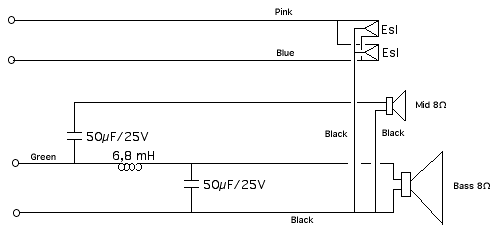 This picture shows the principle of the Colonne crossover circuit. The Picture is not part of the original Charlin document, but included for clarity. Please find a bigger picture (11k) if you click the picture above. A Colonne can be used with an amplifier capable of 50 W sinusoidal music power. The amplifier poses no risk to the loudspeaker. It is different if a tone generator providing sinusoidal or square waves. The energy received by the loudspeaker is 5 to 6 times as high under those conditions as when fed with music. A pair of Colonnes are capable of reproducing, with a astonishing realism, in any room, equally well a concert piano and an orchestra with a choir. If you want an even more powerful reproduction, for a very large room for example, it is very easy to connect two Colonnes head-to-head (that is, on top of each other with the grilles meeting). Under these conditions the grilles are made in a fashion that mixes the sound-output in perfect phase and gives a perfect doubling of the energy. It is possible, in a church, to create a perfect reproduction of even a very large organ provided the speakers are close to the back wall. It is also possible to use 4 colonnes coupled together two by two per channels, ei 8 speakers in total. With this set-up even deepest bass from the largest symphonic organ can be reproduced with perfect fidelity. For the reasons mentioned it is necessary to place the colonnes near a room corner and in a way that allows the listener to sit in the longest area of that room. This allows the best reproduction of the lowest frequencies (large wavelengths). With the loudspeakers positioned this way, and themselves radiating at 90 degrees the two angles superimpose; thereby avoiding reflections from the opposite wall. These reflections should be avoided as they have a ruinous effect on the stereophonic effect, the ear receives sound from the side opposite that of the loudspeaker. For the same reason the stereo effect is enhanced if the walls are not too reflective. It is beneficial to have curtains on one wall (over the windows) and a light cloth on the opposite wall to absorb the highest frequencies. It is also important that the floor is absorbant and covered with a carpet. Under these conditions you will hear a very accurate image between the speakers, provided the recording is of sufficiently high quality. You will a perfect impression of the musicians in front of you, each one in his original place,to the sides as well as in the center and also a perfect image of depth. The sound never seem to come from the loudspeakers but from the space that separate them. Naturally any obstacles between the listener and the grilles of the loudspeakers must be avoided, this includes walls, furniture, lamps etc. which can cause enormous distortion in the stereophonic reproduction. The radiation pattern of Charlin's Colonnes is so homogeneous that no matter where you are in the listening space, the stereophonic image remains stable. The preferred place remains, however, along the axis of the room. But the same thing applies to a live concert. The difference between Charlin's Colonne 160 and 122 is entirely in the reproduction of the very lowest bass (and not in the power handling). With the 122 the range from 32 Hz to the very highest harmonics at 32.000 Hz are covered in a perfectly regular manner. As we have seen, with the 160 we gain yet another octave of bass, going down to 16 Hz (an organ's 32 foot pipe) and this, note per note, with an exceptional regularity. With the Colonnes 160 we thus cover all musical sounds (16 Hz - 32,000 Hz). Here's some pictures of the ColonnesClick on the pictures below for bigger size (100-500 k) |
|||||||
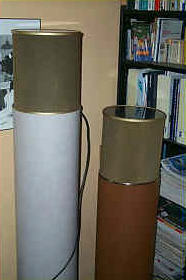
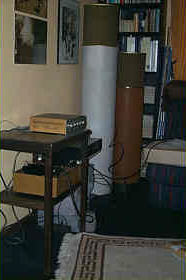
|
|||||||
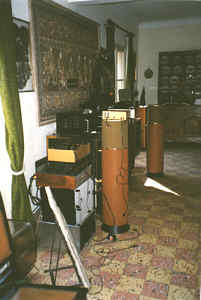
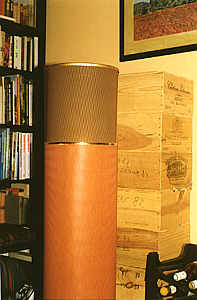
|
|||||||
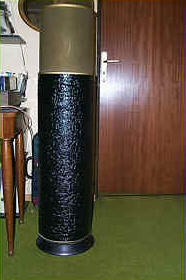
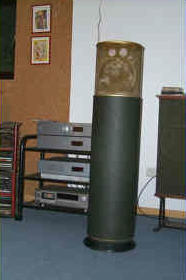
|
|||||||
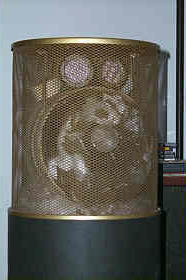
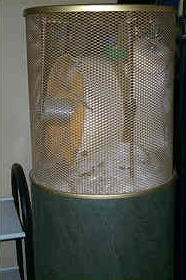
|
|||||||
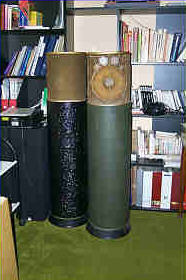
|
